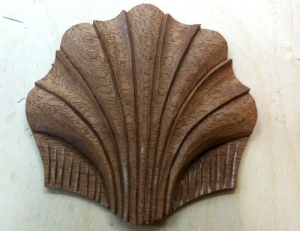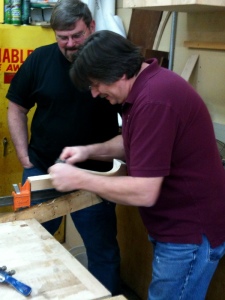Carving Fundamentals Class at Acanthus Workshop
Back in 2008 I picked up some carving chisels wanting to add some carved details to my furniture. I bought just enough chisels to tackle a few practice exercises and to make a Queen Anne fan. Several books and videos later I had tried out several more forms and acquired more chisels to make each one of those forms. It was frustrating that with all the tools I already owned, each new project required a seemingly whole new set of gouges. While the “experts” kept telling me that I didn’t need to buy a lot of tools, I kept seeing them reach into a seemingly endless toolbox and pull out yet one more chisel to execute a specific cut. I understand that through all the compass of shapes and forms you can carve there will be many radii to match and specific situations to address with V tools, veiners, and fishtails. Anyone who carves a wide variety of forms will need a tool kit to match. Here’s the thing: I don’t want to carve all that stuff. I was looking specifically for period furniture details like fans, shells, and acanthus leaves. Even more simply, I was wanting to carve furniture details, not sculptural pieces in the round. All this tool buying for a specific form was discouraging and I wasn’t getting any carving done. Most important of all was that I was not getting to practice the fundamentals of carving by tackling these specific forms. So over the last 4 years I have picked up my carving chisels and put them down hundreds of times to execute ham handed examples of period furniture carvings. I have gotten better results but my speed of work has never improved and it seems my use of sand paper has only increased.

Chuck Bender’s Example Shell
So what do I usually do when I want to cut through all the chaff and get to the core of a skill? I call Chuck Bender. I enrolled in his Carving Fundamentals course and spent 2 days at The Acanthus Workshop. As usual Chuck has a no nonsense (you might say No BS) way of approaching woodworking tasks. His emphasis all weekend was on reading the grain, something that sounds pretty obvious but when confronted with changing grain in a compound convex curve things quickly get confusing. Chuck laid out some very simple exercises that focused us on a specific skill. The object wasn’t really to complete the whole form (we could do that on our own) but just to get a feel for reading the grain in various situations. As each exercise was introduced, he upped the ante by throwing us a curve, literally, in each shape.
Once we had completed straight and flat relief, curved and flat relief, convex relief, concave relief, and combination concave and convex relief carvings it was time to tackle our first actual form. Chuck presented us with a typical Queen Anne shell pattern and went through some great drawing principles to layout our own shape, create a pattern, and saw it out. Then like some kind of Mr Miyagi magic the steps for carving this more complex shape just fell into place. It turns out all that sanding floors, and painting fences early in the weekend paid off and in no time we were shaping our shells.
I have some work still to do on my exercises, and I just ran out of time on my own shell carving, but I feel confident that I can finish them on my own and know how to get myself out of the trouble I will encounter with changing grain direction.
 As usual, another successful weekend at The Acanthus Workshop worth every penny. In typical fashion I didn’t leave with earth shattering knowledge but a lot of subtle little things that improve my skill set across so many areas. Chuck’s teaching style is one that teaches you by doing, but doing so in a controlled manner that ingrains the basic movements into your body.
As usual, another successful weekend at The Acanthus Workshop worth every penny. In typical fashion I didn’t leave with earth shattering knowledge but a lot of subtle little things that improve my skill set across so many areas. Chuck’s teaching style is one that teaches you by doing, but doing so in a controlled manner that ingrains the basic movements into your body.
I urge you to get to Chuck’s school. His DVDs are good (2 new carving DVDs are due out any day) but there is no substitute for being there in person and hearing his solutions and see him do it for specific situations right in front of you. And there is no topic out of bounds. If you have a question about another technique on your mind just ask, you might be surprised what kind of impromptu tutorial ensues.


